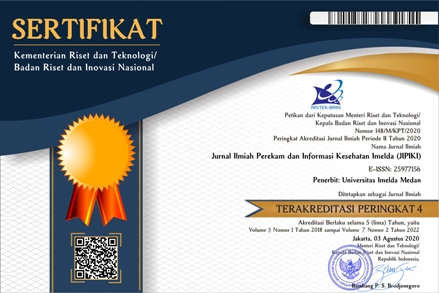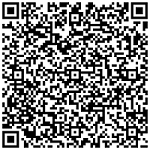Optimalisasi Tracking Rekam Medis Dengan Barcode di Puskesmas Lendah II
DOI:
https://doi.org/10.52943/jipiki.v8i2.1149Keywords:
Information Systems, Outpatient, Registration, SDLC, Visual Studio 2010Abstract
In 2014, primary health centres Lendah II was implemented health information system for primary care (Simpus). the use of simpus can help the physician and health practicioners entry data of patient, import dan export data and also improved theirs performance. The implementation of medical records for primary health centres an important role in managing patient data. The use of technology and information systems in the health sector has an impact on optimizing services. One of them is by utilizing a barcode system to support storage at primary health centres Lendah II This study aims to help the storage tracking system in the filing room using barcodes. Data capture with FGD for needs analysis, then application design and trials. This research uses research and develompent. The results of the study by making class diagrams, barcode applications and examples of barcodes applied to poly service names and medical record numbers. Barcodes will be printed and affixed to the patient's medical record to facilitate tracking of the The barcode of the patient's medical record number will also be affixed to the patient's BPJS card, making it easier for officers to check the patient's medical record number on the simpus. There is a scanner reader tool that will make it easier for officers to read barcode codes.
Downloads
References
Alazzam, M. B., Basari, A. S. H., Sibghatullah, A. S., Doheir, M., Yaacob, N. M., & Aris, F. (2015). Physicians’ acceptance of electronic health records exchange: An extension of the with UTAUT2 model institutional trust. Advanced Science Letters. https://doi.org/10.1166/asl.2015.6531
Allareddy, V., Allareddy, V., & Kaelber, D. (2006). Comparing Perceptions and Use of a Commercial Electronic Medical Record ( EMR ) between Primary Care and Subspecialty Physicians The University of Iowa , Iowa City IA. 47, 2006.
Aikins, M., Abdulai, T. I., Sackey, S., Boni, P., & Afari, E. (2012). Improving Medical Records Filing in a Municipal Hospi-. September.
Akbar, R., Arif Deliyus, F., Adeliani, F., & Olviana, Z. (2017). Implementasi Bussinesee Intelligence Pada Analisis Peningkatan Sarana Perairan Kota Padang Tahun 2013 – 2015 Menggunakan Aplikasi Tableau. KOPERTIP : Jurnal Ilmiah Manajemen Informatika Dan Komputer, 1(2), 59–62. https://doi.org/10.32485/kopertip.v1i02.11
Alexandridis, G., Symeonidou, I., Tzetzis, D., Kakoulis, K., & Kyratsis, P. (2016). An integrated workflow of biomimetic design, material selection and computer aided engineering. Academic Journal of Manufacturing Engineering, 14(4), 12–18.
Austin, J., Barras, M., & Sullivan, C. (2020). Interventions designed to improve the safety and quality of therapeutic anticoagulation in an inpatient electronic medical record. In International Journal of Medical Informatics (Vol. 135). https://doi.org/10.1016/j.ijmedinf.2019.104066
Bowman, S. et al. (2018). Impact of Electronic Health Record Systems on Information Integrity : Quality and Safety Implications (pp. 1–19). AHIMA in chicago, Il
Bouamrane, M., & Mair, F. S. (2013). Open Access A study of general practitioners ’ perspectives on electronic medical records systems in NHSScotland. Biomed Central, 13, 58.
Davis, M. W., McManus, D., Koff, A., Jaszczur, G. R., Malinis, M., Dela Cruz, C., Britto, C. J., Price, C., Azmy, V., Kaman, K., Gaston, D., Early, K., Dewitt, M., Song, J. S., Ortiz, C., Juthani-Mehta, M., & Topal, J. E. (2020). Re-purposing Antimicrobial Stewardship Tools in the Electronic Medical Record for the Management of COVID-19 Patients. Infection Control and Hospital Epidemiology, 1–3. https://doi.org/10.1017/ice.2020.281
Ebnehoseini, Z., Tabesh, H., Jangi, M., Deldar, K., Mostafavi, S. M., & Tara, M. (2021). Investigating evaluation frameworks for electronic health record: A literature review. Open Access Macedonian Journal of Medical Sciences, 9, 8–25. https://doi.org/10.3889/oamjms.2021.3421
Gagnon, M. P., Simonyan, D., Ghandour, E. K., Godin, G., Labrecque, M., Ouimet, M., & Rousseau, M. (2016). Factors influencing electronic health record adoption by physicians: A multilevel analysis. International Journal of Information Management, 36(3). https://doi.org/10.1016/j.ijinfomgt.2015.12.002
Gros, B. (2016). The design of smart educational environments. Smart Learning Environments, 3(1). https://doi.org/10.1186/s40561-016-0039-x
Hartini, S., & Ramadani, M. K. (2011). Perancangan Sistem Informasi Berbasis Barcode dalam Proses Penerimaan , Penyimpanan dan Suplai Material pada Warehouse ( Studi Kasus di Perusahaan Komponen Mobil di Semarang ).
Hirsimaki, R. (2017). Critical Success Factors for Business Intelligence System Implementation. 9(1), 22.
IFHIMA. (2012). Education Module for Health Record Practice Module 3 - Record Identification Systems , Filing and Retention of Health Records. 1–28.
Iswandi, H. (2018). Peran dan Pengaruh Tampilan Desain pada Periklanan. Seni Desain Dan Budaya, volume 3(Issue 3), 100–109.
Jawhari, B., Keenan, L., Zakus, D., Ludwick, D., Isaac, A., Saleh, A., & Hayward, R. (2016). Barriers and facilitators to Electronic Medical Record (EMR) use in an urban slum. International Journal of Medical Informatics. https://doi.org/10.1016/j.ijmedinf.2016.07.015
Kumar, V. (2018). Advancing learning through smart learning analytics : a review of case studies. 13(1), 1–12. https://doi.org/10.1108/AAOUJ-12-2017-0039
Luthuli, L. P., & Kalusopa, T. (2018). The management of medical records in the context of service delivery in the public sector in KwaZulu-Natal, South Africa: the case of Ngwelezana hospital. South African Journal of Libraries and Information Science, 83(2), 1–11. https://doi.org/10.7553/83-2-1679
Msiska, K. E. M., Kumitawa, A., & Kumwenda, B. (2017). Factors affecting the utilisation of electronic medical records system in Malawian central hospitals. Malawi Medical Journal, 29(3). https://doi.org/10.4314/mmj.v29i3.4
Musdholifah, A. (2016). Pengembangan Data Warehouse Menggunakan Pendekatan Data-Driven untuk Membantu Pengelolaan SDM. IJCCS (Indonesian Journal of Computing and Cybernetics Systems), 10(1), 1. https://doi.org/10.22146/ijccs.11184
Massad, S., Dalloul, H., Ramlawi, A., Rayyan, I., Salman, R., & Johansson, L. A. (2019). Accuracy of mortality statistics in Palestine: A retrospective cohort study. BMJ Open, 9(4), 1–8. https://doi.org/10.1136/bmjopen-2018-026640
Muinga, N., Magare, S., Monda, J., Kamau, O., Houston, S., Fraser, H., Powell, J., English, M., & Paton, C. (2018). Implementing an open source electronic health record system in kenyan health care facilities: Case study. JMIR Medical Informatics, 20(4), 1–13. https://doi.org/10.2196/medinform.8403
Nguyen, L., Bellucci, E., & Nguyen, L. T. (2014). Electronic health records implementation : An evaluation of information system impact and contingency factors. International Journal of Medical Informatics, 83(11), 779–796. https://doi.org/10.1016/j.ijmedinf.2014.06.011
Phillips, A., Physio, B. A., Health, H., Physio, S., Stiller, K., Physio, B. A., Williams, M., & Physio, B. A. (2006). Medical Record Documentation : The Quality of Physiotherapy Entries. 4(3).
Shoolin, J. S. (2010). Change management - recommendations for successful electronic medical records implementation. Applied Clinical Informatics, 1(3), 286–292. https://doi.org/10.4338/ACI-2010-01-R-0001
Struik, M. H. L., Koster, F., Schuit, A. J., Nugteren, R., Veldwijk, J., & Lambooij, M. S. (2014). The preferences of users of electronic medical records in hospitals: Quantifying the relative importance of barriers and facilitators of an innovation. Implementation Science. https://doi.org/10.1186/1748-5908-9-69
Taylor, P., & Holden, R. J. (2009). Behaviour & Information Technology A theoretical model of health information technology usage behaviour with implications for patient safety. April 2013, 37–41. https://doi.org/10.1080/01449290601138245
Vennila, G., Arivazhagan, D., & Jayavadivel, R. (2020). An analysis of smart car parking management system. International Journal of Scientific and Technology Research, 9(1), 1892–1895.
World Health Organization. (2006). Medical Records Manual : A Guide for Developing Countries.
Zulfikar, R. A., & Supianto, A. A. (2018). Rancang Bangun Aplikasi Antrian Poliklinik Berbasis Mobile. Jurnal Teknologi Informasi Dan Ilmu Komputer, 5(3), 361. https://doi.org/10.25126/jtiik.201853891
WHO, world health organization. (2015). State of inequality. 124.











